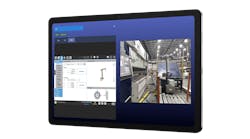Before we can examine the differences among the terms, let’s try and define what each one means. “Everyone knows the history of the PLC’s invention and its father, the great Dick Morley,” says Jeff Payne, product manager of the Automation Controls Group at AutomationDirect.
“The story of the first PLC and the creation of Modicon is one of true entrepreneurial genius that would forever change the way we control machines,” says Payne. “This relay replacer has taken on many faces over the past 50 years, growing from a simple logic solver to a true multi-tasking central core for many systems.”
The term “programmable automation controller” (PAC) was a way to provide some distinction among controllers, continues Payne. “On one end of the market, many legacy controllers were similar to the units Morley speaks of in his memoirs,” he says. “However, on the other end of the industrial control spectrum, there was a wave of new technology being introduced, often applying advancements from commercial technologies.”
Also read: Use PLC programming, not custom code
The industrial PC (IPC) has actually been around longer than the PAC, explains Payne. “But for many years these were simply repackaged commercial units not suitable for industrial applications,” he says. “There were also reliability concerns with Windows and other desktop operating systems. But great strides have been made in this area, and the IPCs of today are as reliable as PLCs and PACs.”
Derrick Stacey, solutions engineer at B&R Industrial Automation, gives his take on PC terminology. “IPCs make use of consumer-grade operating systems, such as Windows or Linux, to allow integration of standard hardware via USB, PCI cards or hardware drivers and to allow for open integration and development with any platform, such as .NET or Visual Studio,” he says. “They also provide the ability to make use of media capabilities like media players, PDFs and text editors. A specific example is a CNC machine using a Windows 3D visualization plug-in requiring the video card in a PC to render their parts prior to machining.”
Payne introduces another label, which may help to define a particular class of controllers more closely. “A term you may be seeing more frequently is PLC-based PAC,” he explains. “This class of controller fits a very broad range of applications ranging from simple, low-cost machine control up and through much of the higher-end PAC- and IPC-class applications.”
Defining the terms and adding a new one doesn’t necessarily bring clarity, as Tom Wohlwender, product sales manager for Advantech, points out. “The real culprit to this confusion is the PAC,” he explains. “This hybrid device steps into the PLC and IPC worlds, muddying the water and making it difficult to define distinct differences.”
Ask three different people what a PAC is, and you’ll likely get three different answers, says Wohlwender. “A PAC can always serve as a PLC, but a PLC probably can’t serve as a PAC,” he cautions. “Most think of a PAC as an IPC with built-in I/O. Both the PLC and the IPC are built for industrial service, but the PLC has better accommodations for I/O with features such as high-density inputs and outputs.”
Unlike the PLC, the IPC often hosts standard and industrial versions of PC operating system such as Windows and Linux, continues Wohlwender. “PLCs, however, typically run on proprietary platforms and are thus supplier-dependent for functions such as programming and expansion,” he explains. “Because IPCs run on PC platforms, they contain more modern processors and more memory than standard PLCs, and they offer more flexibility. All of the functions of a PC are inherent in an IPC, including the ability to host multiple operating systems and applications.”
More shade is thrown on the PAC term by John Kowal, director of business development at B&R Industrial Automation. “The term PAC was invented by an industry analyst and is completely arbitrary and actually kind of nonsensical,” he explains. “When is a PLC not a PLC? When is it a PAC? People use the term ‘PLC’ for lots of control functions besides logic. And that's fine, because it's come to mean an industrial type of controller.”
The term Kowal says he’s preferred for more than a decade is “automation controller,” as the programmable part is redundant. “An automation controller is going to perform I/O control, visualization, safety, robotics, motion and other control functions in any of a number of form factors,” he explains. “It may or may not run Windows. It may be in a traditional PLC rack configuration, or it may be integral to a touch panel. It may be a stand-alone industrial computer, or it may reside as a module in a multi-axis servo rack. The important distinction is that modern automation controllers follow Moore's Law and use the latest mainstream processors as their foundation. The ones that don't, I would call ‘PLCs.’”
As always, the application drives the selection of the right machine controller, regardless of the terminology. In choosing the right controller, Wohlwender identifies several factors to help to point to the best solution including:
• complexity of logic and control
• density and type of I/O
• network and communication requirements
• desired programming method
• integration with other systems and applications.
“An experienced system provider can help machine builders to pick the right type of controller,” says Wohlwender. “Choosing the best platform from the beginning is the key to assuring a project will be a success.”
Although calling some products PACs may have introduced confusion, it has also driven some suppliers to add features to PLCs, many of which directly benefit machine builder OEMs. “In the past, many machine builders were faced with trying to use a smaller PLC ideal for the I/O requirements and physical space constraints, but marginal with regard to performance, particularly regarding scan times,” explains Payne. “The alternative was to make the switch to a higher-end PAC or IPC, but in many cases these larger controllers were overkill for the simple machine control requirements, and that drove up the cost of the overall design by requiring a larger enclosure, along with higher hardware and software prices.”
Newer controllers, whether they are called PACs or PLC-based PACs, address these and other issues by taking advantage of advances in commercial technologies to offer more capable controllers packaged in smaller housings, all at lower price points. And, in the end, this is what machine builders want, no matter what term is used to label the controller.
Homepage image courtesy of Feelart at FreeDigitalPhotos.net




